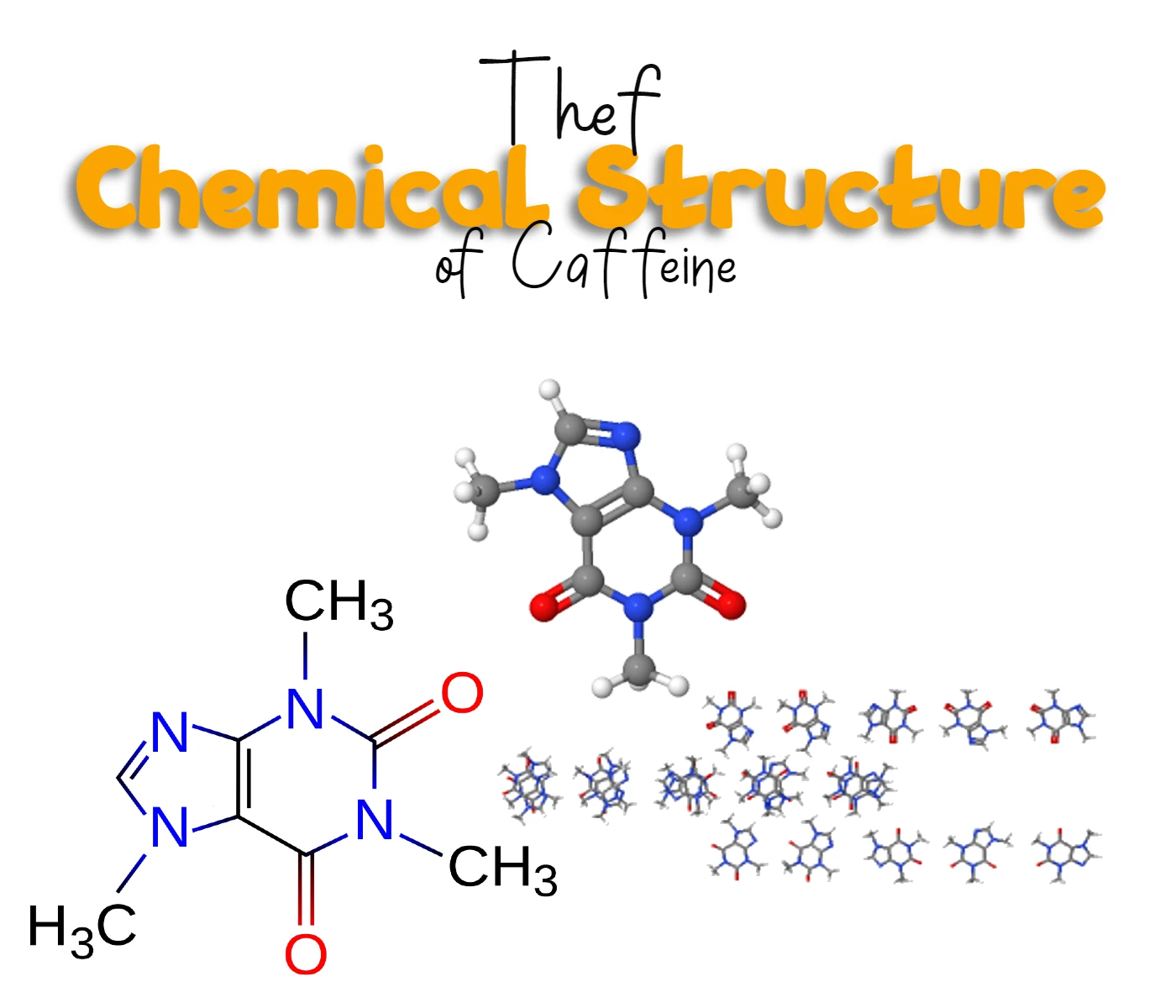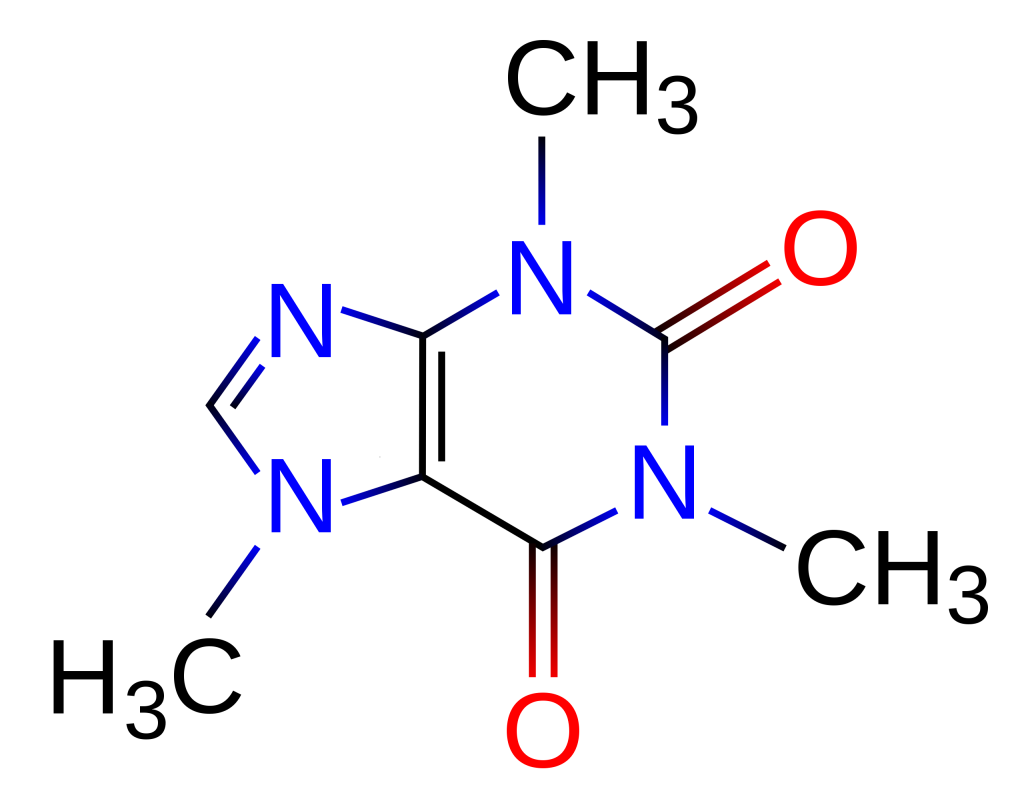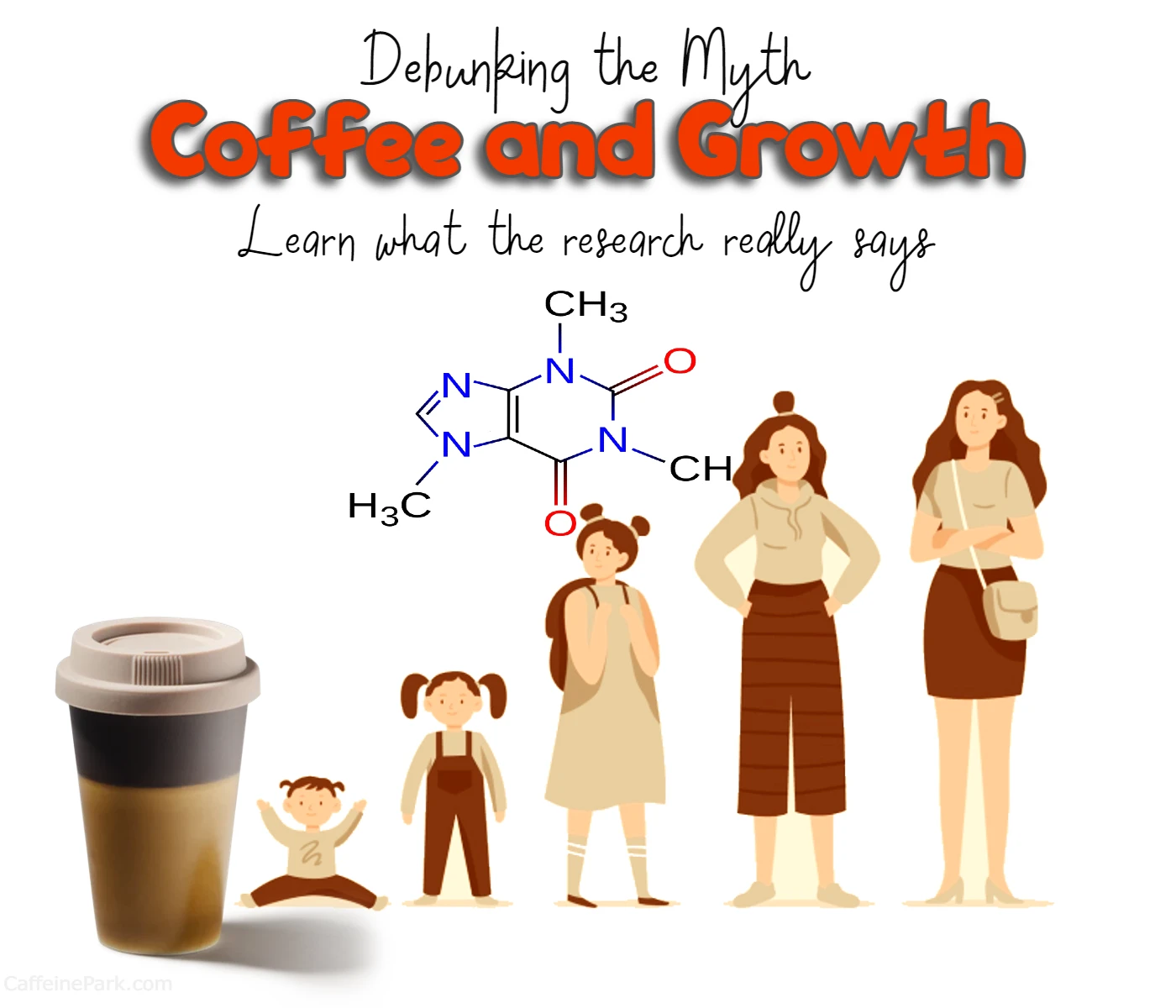
Caffeine, one of the world’s most widely consumed psychoactive substances, is a naturally occurring compound that belongs to a class of alkaloids called methylxanthines. With a molecular formula of C8H10N4O2 and a molar mass of 194.194 g/mol, caffeine is made up of carbon, hydrogen, nitrogen, and oxygen atoms arranged in a specific way to give it its unique properties.
| Fact | Information |
|---|---|
| Chemical formula | C8H10N4O2 |
| Molecular weight | 194.19 g/mol |
| Molecular structure | Triazinylpurine |
| Classification | Methylxanthine |
| Melting point | 235-238 °C |
| Solubility in water | 2.17 g/L at 25 °C |
| Solubility in organic solvents | Soluble in organic solvents like chloroform and ethyl acetate |
| Boiling point | 178 °C at 4 mmHg |
| Appearance | White crystalline powder or needle-like crystals |
| Sources | Coffee, tea, cacao, kola nuts, yerba mate, guarana, etc. |
Chemical Structure
The chemical structure of caffeine can be represented by its IUPAC name, 1,3,7-trimethylpurine-2,6-dione. The structure features a purine ring, which is a fused ring system consisting of two adjacent nitrogen-containing heterocyclic aromatic rings, and three methyl groups (CH3) located at positions 1, 3, and 7 on the purine ring. Two carbonyl (C=O) groups are also present at positions 2 and 6 on the purine ring.
The chemical formula for caffeine can also be used to describe its structure, with eight carbon atoms (C8), ten hydrogen atoms (H10), four nitrogen atoms (N4), and two oxygen atoms (O2) arranged in a specific way.

Physical Properties
Caffeine is a white, crystalline solid with a bitter taste and no odor. It has a density of 1.23 g/cm3, and its melting point is in the range of 235 to 238 °C for the anhydrous form. The boiling point of caffeine is 178 °C, which is below the temperature at which it decomposes.
Solubility
Caffeine is slightly soluble in water, with a solubility of about 2 g/L at room temperature. It is also moderately soluble in ether and more soluble in organic solvents such as ethanol and chloroform. The solubility of caffeine is affected by factors such as temperature, pH, and the presence of other substances.
Caffeine in Plants
Caffeine is found naturally in a variety of plants, including coffee, tea, cocoa, and the kola nut. In these plants, caffeine serves as a natural pesticide, deterring herbivores from eating the plant by paralyzing and killing the insects that consume it. The caffeine content in these plants can vary widely depending on the species and growing conditions, but it generally ranges from 0.1 to 2% of the dry weight of the plant material.
Caffeine in Food and Beverages
Caffeine is perhaps most well-known for its presence in food and beverages consumed by humans, including coffee, tea, energy drinks, and chocolate. Coffee is one of the primary sources of caffeine, with an average cup of coffee containing between 60 and 100 mg of caffeine, although this can vary depending on factors such as the type of coffee bean, the brewing methods, and the serving size.
Tea also contains caffeine, although at lower levels than coffee. An average cup of black tea contains about 30 to 50 mg of caffeine, while green tea contains between 20 and 40 mg of caffeine per cup. Energy drinks can contain even higher amounts of caffeine, with some brands containing as much as 500 mg per serving.
In addition to coffee, tea, and energy drinks, caffeine is also found in chocolate and other products made from cacao beans. While the caffeine content in chocolate is relatively low, with a typical serving containing between 5 and 20 mg of caffeine, it can still contribute to the overall caffeine intake of an individual.
Psychotropic Effects of Caffeine
Caffeine is widely known for its psychotropic effects, including increased alertness, wakefulness, and mental acuity. This is because caffeine blocks adenosine receptors in the brain, which can result in an increase in the activity of certain neurotransmitters, including dopamine and norepinephrine. Dopamine is associated with the reward center of the brain and is linked to feelings of pleasure, while norepinephrine is associated with increased heart rate, blood pressure, and the “fight or flight” response.
Anti-Inflammatory Effects of Caffeine
Caffeine has been found to have anti-inflammatory effects due to its ability to inhibit phosphodiesterases (PDEs). PDEs are enzymes that break down cyclic AMP (cAMP), a molecule that plays a key role in many cellular processes, including immune function. By inhibiting PDEs, caffeine increases the levels of cAMP in cells, which can activate protein kinase A (PKA), a signaling molecule that helps to regulate immune function.
PKA can inhibit the synthesis of leukotrienes, which are pro-inflammatory molecules produced by immune cells. By inhibiting leukotriene synthesis, caffeine can reduce inflammation and the innate immune response. This anti-inflammatory effect has been shown to be useful in the treatment of certain inflammatory conditions, such as asthma, bronchitis, and arthritis.
Potential Health Benefits of Caffeine
In addition to its psychotropic and anti-inflammatory effects, caffeine has also been associated with a number of potential health benefits. These include:
- Improved Cognitive Function: Caffeine has been shown to improve cognitive function, including memory, attention, and reaction time.
- Reduced Risk of Parkinson’s Disease: Some studies have suggested that regular consumption of caffeine may be associated with a reduced risk of Parkinson’s disease, a neurodegenerative disorder.
- Reduced Risk of Alzheimer’s Disease: Similarly, some studies have suggested that regular consumption of caffeine may be associated with a reduced risk of Alzheimer’s disease, another neurodegenerative disorder.
- Reduced Risk of Type 2 Diabetes: Some studies have suggested that regular consumption of caffeine may be associated with a reduced risk of type 2 diabetes.
- Reduced Risk of Liver Disease: Some studies have suggested that regular consumption of caffeine may be associated with a reduced risk of liver disease, including cirrhosis and liver cancer.
It is important to note, however, that the evidence for these potential health benefits is not conclusive, and more research is needed to fully understand the effects of caffeine on human health.
Conclusion
Caffeine is a methylxanthine alkaloid that is widely consumed around the world for its psychotropic effects, including increased alertness and wakefulness. Caffeine works by blocking adenosine receptors in the brain, which can result in an increase in the activity of certain neurotransmitters, including dopamine and norepinephrine. Caffeine also has anti-inflammatory effects due to its ability to inhibit PDEs, which can reduce inflammation and the innate immune response.
While caffeine has been associated with a number of potential health benefits, more research is needed to fully understand its effects on human health. In addition, it is important to be aware of the potential risks associated with consuming large amounts of caffeine, including anxiety, insomnia, and increased heart rate and blood pressure. As with any substance, it is important to consume caffeine in moderation and to be aware of your personal tolerance and sensitivity to its effects.
FAQs
The chemical formula of caffeine is C8H10N4O2.
The molecular weight of caffeine is 194.19 g/mol.
The IUPAC name of caffeine is 1,3,7-trimethylpurine-2,6-dione.
The chemical structure of caffeine consists of a purine base with two substituents, each of which is a methyl group, and two carbonyl groups.
Caffeine acts as an adenosine receptor antagonist in the central nervous system. Adenosine is a naturally occurring compound that has a sedative effect on the brain, and when caffeine binds to adenosine receptors, it inhibits the sedative effects of adenosine, leading to increased alertness and wakefulness.
Caffeine is used in some medications to treat conditions such as headache, pain, and fatigue. It is also sometimes used in combination with other drugs to enhance their effects.
Read More:





